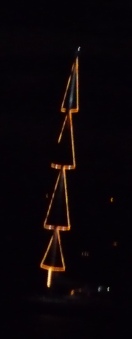Blackbeard’s, it turned out, is not really a castle and it is doubtful that there was ever a connection to Blackbeard the Pirate, but the name makes for a good marketing device. Disneylike pirate statues are strewn about the grounds, and it soon became clear that this national landmark is more about making a profit than disseminating information. The entire historic site, along with a whole swath of hillside facing the harbor, has been acquired by a group of investors. The old colonial houses may be worth the price of admission, but the emphasis is on shopping. An educational exhibit on rum making provides an opportunity to sell visitors bottles of Cruzan rum, with free delivery to your cruise ship. While marveling at the specimens in the amber museum — ancient bugs stuck in petrified tree sap — visitors are befriended by enthusiastic young guides who try their best to sell amber jewelry. The owners of Blackbeard’s are the real pirates of the Caribbean.
I was thinking about their treachery when, after half a day on the water, our boat pulled into Pirate’s Bight on Norman Island, which promotes itself as the template for Robert Louis Stevenson’s Treasure Island. Norman is owned, all 610 acres of it, by Henry Jarecki, a psychiatrist-turned-investment banker and land developer. Even the smallest Caribbean islands now have their own websites, and Norman Island has live webcams aimed at the beach and the inside the bar.
We spent the night moored a hundred yards beyond their sight. As darkness fell, neighboring boats lit battery-powered Christmas bulbs. The mast of a large catamaran was rigged with triangles of white lights, a constellation in the shape of a four-story Christmas tree. As its reflection rippled on the water I tried to remember a few lines from a Wallace Stevens poem, The Idea of Order at Key West, that I’d used as an epigraph in one of my books:
The lights in the fishing boats at anchor there,
As the night descended, tilting in the air,
Mastered the night and portioned out the sea,
Fixing emblazoned zones and fiery poles,
Arranging, deepening, enchanting night.

George Johnson
The Santa Fe Review
